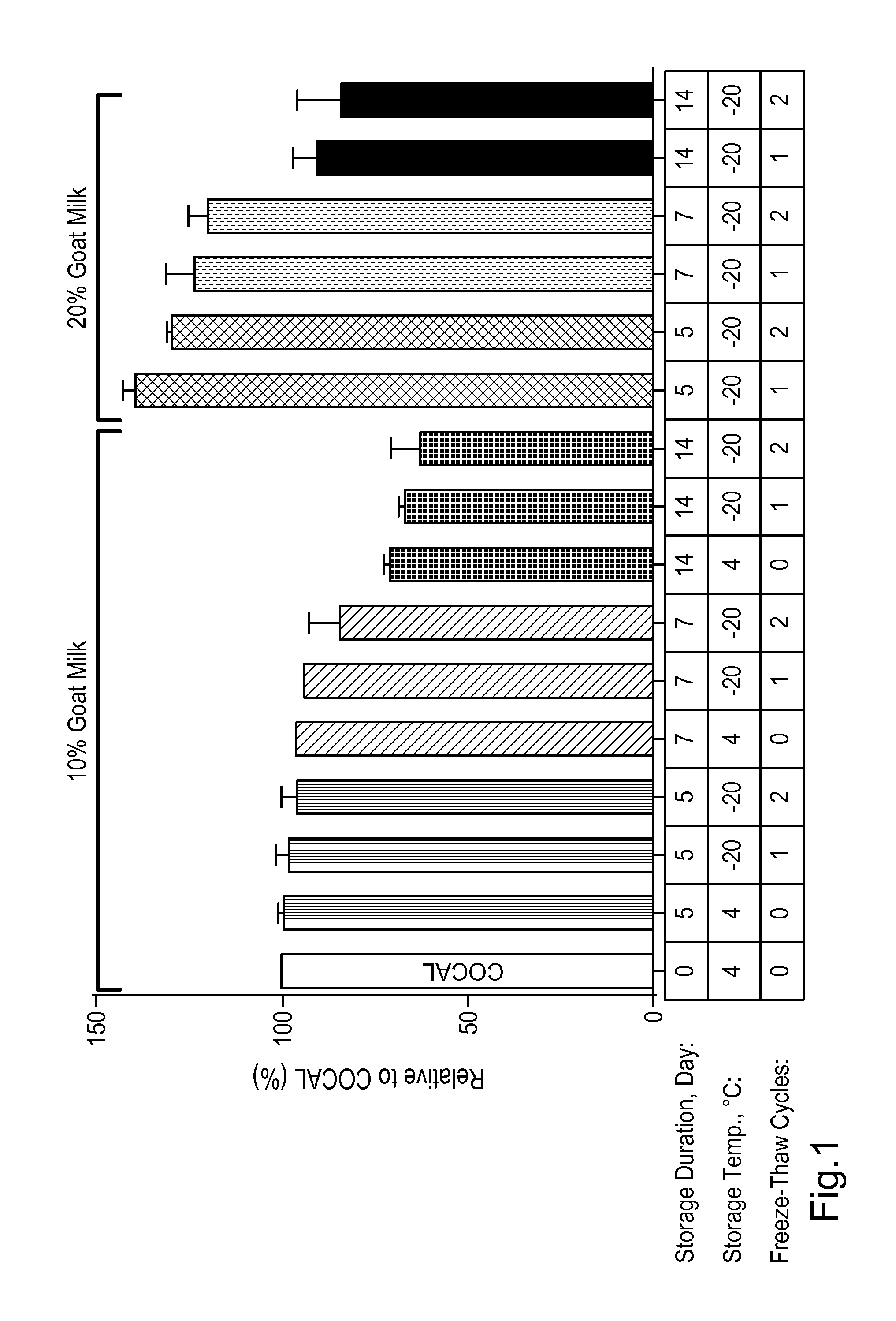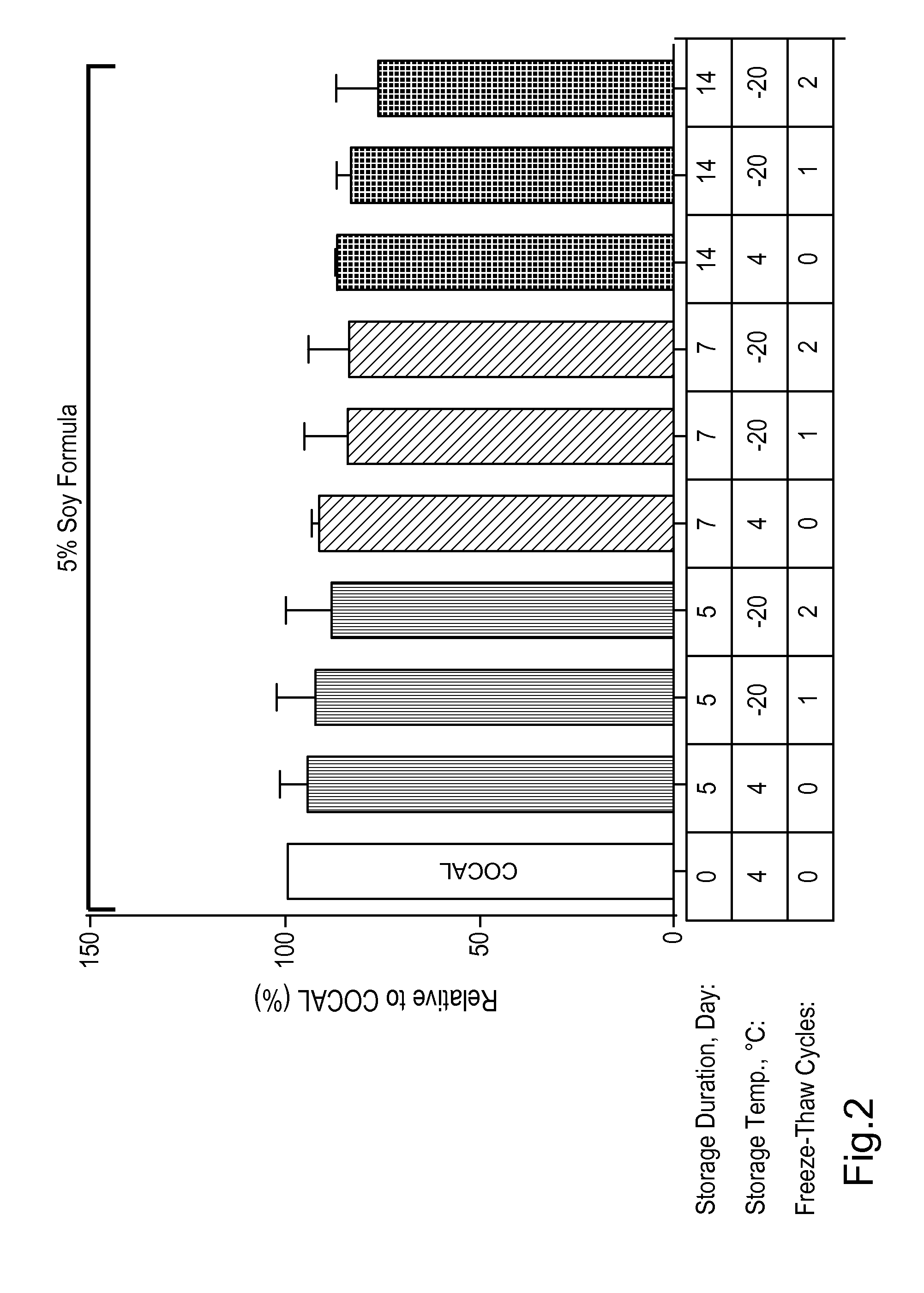Adulteration testing of human milk
a human milk and adulteration technology, applied in the field of adulteration testing of human milk, can solve problems such as questions, and achieve the effect of reducing the bio-burden of the fat portion
- Summary
- Abstract
- Description
- Claims
- Application Information
AI Technical Summary
Benefits of technology
Problems solved by technology
Method used
Image
Examples
example 1
Detection of Adulterants in Human Milk
[0089]To prevent the use of human milk that has been adulterated with non-human milk or infant formula, an assay to detect the presence of adulterants that uses very little breast milk is needed. This study was performed in order to determine if commercially available ELISA kits can be used to detect the presence of cow milk, goat milk, dairy-based infant formula, soy milk, and soy-based infant formula in human breast milk.
[0090]Veratox® ELISA kits for the detection of milk proteins, casein and whey, and soy proteins in food products are commercially available from Neogen Corporation. The Total Milk Allergen kit was used to screen for the presence of cow milk, goat milk, and dairy-based infant formula in human milk, and the Soy Allergen kit was used to screen for the presence of soy milk and soy-based infant formula in human milk. The kits were validated to screen for adulteration of human breast milk at a 10% adulteration cutoff level. Goat mil...
example 2
Detection of Adulterants in Smaller Samples of Pooled Human Milk
[0100]This study was performed in order to determine if ten donors could be pooled per test sample for screening purposes, and if using a reduced sample volume of 100 μL per donor would produce similar results to those obtained using a sample volume of 1 mL.
[0101]Different donor volumes were compared to the results obtained in Example 1. For both kits samples were prepared using: (1) 1 mL of human milk from one donor (adulterated at 10%)+25 mL of PBS and (2) 1 mL of milk from ten donors combined (100 μL each, with one of them adulterated at 10%)+1.6 mL PBS. The final concentration of adulterant in PBS is the same in both samples.
[0102]Adulteration levels compared were 0% and 5% for all adulterants, as well as 10% Goat Milk and 10% Soy Formula as the cutoff calibrators in the Veratox® Total Milk Allergen and Veratox® Soy Allergen kits respectively. A 20% Goat Milk adulteration sample was also included in the Veratox® Tot...
example 3
Automated Detection of Adulterants in Pooled Human Milk
[0125]This study was performed in order to determine if the manual methodologies for the detection of cow, goat, and soy proteins in human breast milk described in the previous examples may be performed using an automated system to provide a robust and reliable method for detecting adulteration of human milk pools of ten donors while consuming an insignificant volume of human milk.
[0126]Human breast milk was provided by ten donors (15607 (A.1), 15966 (A.2), 16226 (B), 16528 (C), 16580 (D), 17046 (E), 17076 (F), 17193 (G), 17363 (H), and 17617 (I)). The non-human milk and infant formula samples used were purchased from a grocery store. The following five milk and infant formula samples were used as adulterants: Cow Milk (Hiland Vitamin D milk; Grade A, pasteurized and homogenated or Horizon Organic Vitamin D milk, ultra pasteurized and homogenated, DHA Omega-3), Goat Milk (Meyenberg Ultra Pasteurized Vitamin D milk), Cow Milk-bas...
PUM
| Property | Measurement | Unit |
|---|---|---|
| temperature | aaaaa | aaaaa |
| temperature | aaaaa | aaaaa |
| volumes | aaaaa | aaaaa |
Abstract
Description
Claims
Application Information
 Login to View More
Login to View More - R&D
- Intellectual Property
- Life Sciences
- Materials
- Tech Scout
- Unparalleled Data Quality
- Higher Quality Content
- 60% Fewer Hallucinations
Browse by: Latest US Patents, China's latest patents, Technical Efficacy Thesaurus, Application Domain, Technology Topic, Popular Technical Reports.
© 2025 PatSnap. All rights reserved.Legal|Privacy policy|Modern Slavery Act Transparency Statement|Sitemap|About US| Contact US: help@patsnap.com



